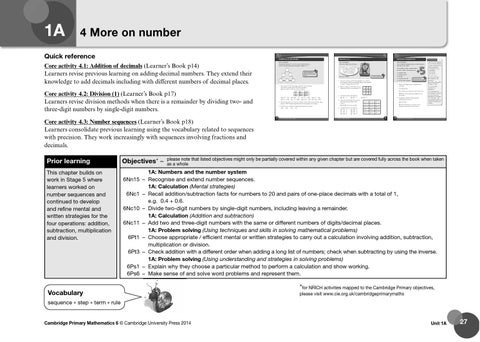1A
4 More on number
Quick reference Core activity 4.1: Addition of decimals (Learner’s Book p14) Learners revise previous learning on adding decimal numbers. They extend their knowledge to add decimals including with different numbers of decimal places.
Addition of decimals
Division (1)
Let’s investigate
Let’s investigate
Let’s investigate
Arrange the numbers 0.1, 0.2, 0.3, 0.4, 0.5 and 0.6 in the circles so the sum along each side of the triangle is 1.2.
Abdul was asked how old he was.
Choose different starting numbers to make sequences that have a rule ‘add 5’.
If my age is divided by 2 or 3 or 4 there is 1 left over.
Is it possible to make a sequence where the rule is ‘add 5’ and the terms are:
If my age is divided by 7 there is no remainder.
Try using numbers on cards or small pieces of paper, that you can move around.
multiples of 5? multiples of 10? List the multiples of 7.
How old is Abdul?
all odd? include 24 and 39?
1
Core activity 4.2: Division (1) (Learner’s Book p17) Learners revise division methods when there is a remainder by dividing two- and three-digit numbers by single-digit numbers. Core activity 4.3: Number sequences (Learner’s Book p18) Learners consolidate previous learning using the vocabulary related to sequences with precision. They work increasingly with sequences involving fractions and decimals.
Number sequences
The answers to the following questions are in the grid. Find which answer goes with which question. Which number is not one of the answers? 8.28
2 3
Vincent wants to put 75 photographs in an album. A full page holds 6 photographs. What is the smallest number of pages Vincent uses?
2
Which number on the grid can be divided by 8 with a remainder of 1?
2.05
7.8
5.41
12.18
13.95
4.98
12.21
3
(a) 4.61 ! 0.8
(b) 0.45 ! 1.6
(c) 3.7 ! 4.58
(d) 6.1 ! 7.85
(e) 4.3 ! 0.68
(f) 7.5 ! 4.68
(g) 4.25 ! 7.96
(h) 3.45 ! 0.85
4
5.55
5.15
5.5
Unit 1A: Core activity 4.1 Addition of decimals
(b) 68 ! 7
Copy the grid. Shade the squares that have a remainder in the answer. What letter have you made?
Find the sum of all the numbers less than 5.5 in this list. 5
67
72
51
42
73
64
60
20
69
are not whole numbers?
Complete these calculations: (a) 132 ÷ 6
(b) 146 ÷ 9
(c) 147 ÷ 2
(d) 107 ÷ 4
(e) 156 ÷ 8
(f) 148 ÷ 9
Unit 1A: Core activity 4.2 Division (1)
You will need to try different starting numbers.
step: the ‘jump size’. For example, in the sequence 60 110 160 210 +50
1
Here is the beginning of a sequence of numbers: 8, 16, 24, 32, 40 ... The sequence continues in the same way. Will 88 be in the sequence? Explain how you know.
Complete these calculations: (a) 78 ! 4
Kiki has two pieces of rope. One piece is 93.7 metres long and the other piece is 125.9 metres long. What is the total length of her rope? 5.05
14
4.3
1
Vocabulary sequence: an ordered set of numbers, shapes or other mathematical objects arranged according to a rule. For example, 3, 6, 9, 12, 15 … 1, 4, 9, 16, 25 … !"#!"#!
(c) 98 ! 6
2
41 ÷ 4
47 ÷ 9
48 ÷ 5
14 ÷ 4
25 ÷ 5
31 ÷ 3
55 ÷ 6
27 ÷ 6
50 ÷ 7
34 ÷ 7
48 ÷ 6
54 ÷ 9
60 ÷ 8
54 ÷ 6
49 ÷ 7
A sequence starts at 200 and 30 is subtracted each time. 200, 170, 140 ...
+50
+50
the step is ’!50’. term: one of the numbers in a sequence. rule: a rule tells you how things or numbers are connected. For example, the numbers 3, 7, 11, 15, 19 … are connected by the rule ‘add 4 to the previous number’.
What are the first two numbers in the sequence that are less than zero?
17
18
Unit 1A: Core activity 4.3 Number sequences
please note that listed objectives might only be partially covered within any given chapter but are covered fully across the book when taken as a whole
Prior learning
Objectives* –
This chapter builds on work in Stage 5 where learners worked on number sequences and continued to develop and refine mental and written strategies for the four operations: addition, subtraction, multiplication and division.
1A: Numbers and the number system 6Nn15 – Recognise and extend number sequences. 1A: Calculation (Mental strategies) 6Nc1 – Recall addition/subtraction facts for numbers to 20 and pairs of one-place decimals with a total of 1, e.g. 0.4 + 0.6. 6Nc10 – Divide two-digit numbers by single-digit numbers, including leaving a remainder. 1A: Calculation (Addition and subtraction) 6Nc11 – Add two and three-digit numbers with the same or different numbers of digits/decimal places. 1A: Problem solving (Using techniques and skills in solving mathematical problems) 6Pt1 – Choose appropriate / efficient mental or written strategies to carry out a calculation involving addition, subtraction, multiplication or division. 6Pt3 – Check addition with a different order when adding a long list of numbers; check when subtracting by using the inverse. 1A: Problem solving (Using understanding and strategies in solving problems) 6Ps1 – Explain why they choose a particular method to perform a calculation and show working. 6Ps6 – Make sense of and solve word problems and represent them.
Vocabulary
*for NRICH activities mapped to the Cambridge Primary objectives, please visit www.cie.org.uk/cambridgeprimarymaths
sequence • step • term • rule
Cambridge Primary Mathematics 6 © Cambridge University Press 2014
Unit 1A
27
